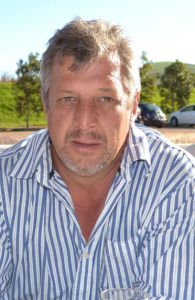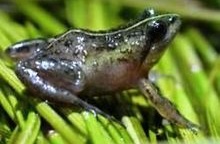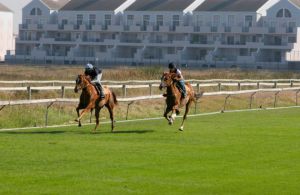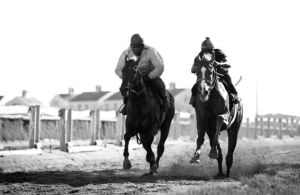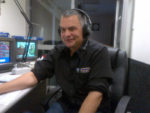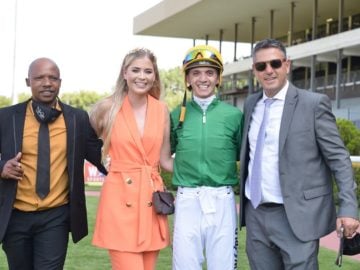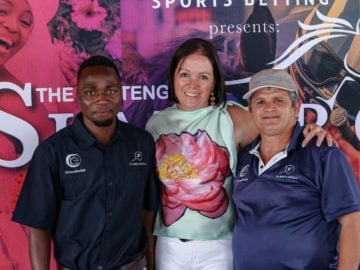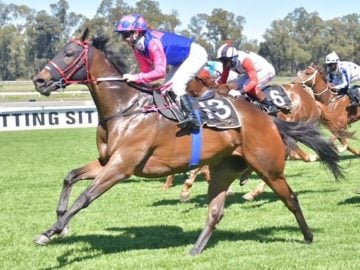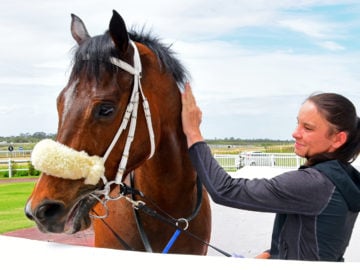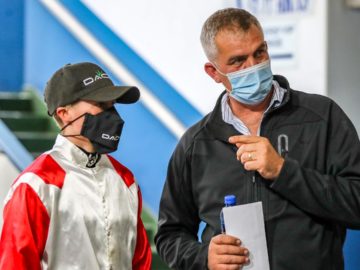Dean Diedericks has been Kenilworth’s track manager for 8 years and was recently promoted to GM Racing for the Western Cape. We meet the talent behind the turf.
Name
Ulrich Dean Diedericks (but I prefer just Dean).
What is your background?
I was born and bred in Wartburg, just north of Pietermaritzburg. My dad was a teacher most of his life and taught at Kearsney College. I did my primary schooling at Hillcrest and high school at Kearsney. After Std 8, I transferred to Weston Agricultural College and matriculated there. After the army, I studied Horticulture for 4 years at Durban Tech. From there it was a natural progression into either propogation (nursery) or landscaping. I started out at Zululand Nursery in Eshowe and then got a job as a farm manager in the Tuli block in Botswana. I was there for about 2 years. I met a girl, got married and the rest is history! We have 2 boys. The eldest is 18 and is completing matric at Durbanville High School. Our youngest is in Std 7.
How did you get into racing ?
My wife (girlfriend at the time) and I decided to come back to SA. My boss had asked me to stay in Botswana for 3 months and I came down to Pretoria for a weekend and saw a newspaper ad for an assistant track manager at the Vaal. I rang up and sent through my application and they invited me for an interview that same afternoon. I got the job and have been doing track management for 20 odd years.
When did you get to Cape Town?
After the Vaal, I moved to Gosforth Park for 4 years, then Newmarket and then over to Turffontein when they were building the new track. Bradford Smith was manager at Randjes at the time and he decided to move on, so I took over from him. About 8 years ago I got a call from Eddie Luff and Brian Beryl and they offered me a position in the Western Cape.
You have a wealth of experience.
It’s not an exact science. Each track is different, so there are no books to study – it’s a feel thing. You develop it over years and it comes with experience. I like to hope that I’m a bit more knowledgeable than most though.
Was it a big transition to Cape Town?
The grass tracks require more hands on work and being closer to the coast, diseases are more of a problem. Kikuyu grows well in the Highveld, but it does not grow naturally in the coastal areas, which is why Durban in particular takes strain.
Does Kenilworth’s central nature reserve present challenges?
It would be fair to say we have a love/hate relationship with Cape Nature! The reserve contains Cape Flats Fynbos and there are only a few isolated pockets of it left. The protected micro frog and about 34 endangered plant species are unique to Kenilworth. Because it’s so delicate, there are a number of protocols in place to protect it and we need to be careful about fertilizers, herbicides and fungicides and keep meticulous records of everything we use. Then there are Egyptian geese that eat the track, guinea fowl and francolin that dig up our divots, plus moles, insects and parasites that need dealing with, but it’s a unique and special place.
What is the workload on our Cape tracks?
We race roughly 80 times a year and that’s split approximately 30 / 50 between Durbanville and Kenilworth.
Do you have a lot of staff?
Unlike elsewhere, we mostly rely on permanent staff. We have 32 at Kenilworth, 20 at Durbanville, 20 at Milnerton, 12 at Philippi and 5 at the quarantine station, plus 15 roving maintenance guys who do the building, electrical and plumbing jobs. We handle everything from general grounds management to things like cabling on big race days. It’s a small team, but we work well together – we have to! I have a good team of venue managers and Teresa is exceptionally good at what she does.
Pressures of the job?
Fortunately I’m not the first line of defence! Trainers mainly need help in terms of stabling facilities and general maintenance. Jockeys focus on the racing surfaces. I also work very closely with Ernie Rodrigues and we have a good understanding.
Without the OTA, how do you get feedback from the jockeys, trainers, etc?
There are quarterly industry liaison meetings attended by industry representatives. These are formal, structured meetings and are minuted. Other than that, I try to be proactive. I’m at all the venues at least once a week and rely heavily on feedback from trainers and jockeys.
Any changes since Phumelela took over?
I worked for Phumelela for 10 years, so I know where they’re coming from. I’d say things are going well. There are teething problems and probably will be for a while, but I believe there is light at the end of the tunnel. I think the Cape will be an exciting racing jurisdiction in the very near future.
Why is Durbanville unpopular?
I don’t think it’s any secret that the track is undulating. We try to address problems during our annual treatments, but it does need a make-over and we’ll need to spend money there. At this stage, we’re not sure whether we’ll upgrade the grass or go the synthetic route – it’s up to Phumelela to make that call.
Synthetics are big investment and Durbanville is a leased property?
That is so, but as we’ve seen in Joburg, there is scope for a racecourse outside the city centre. Durbanville is a great venue, particularly for the younger crowd. Kids don’t go to Town to party anymore, they come to Durbanville.
How do you manage grass gallops?
At Kenilworth, the rule is a feature race runner and a companion. There is scope for abuse, so in the interest of fairness, we’ve acquired a microchip scanner. Trainers complete a gallop request form 24 hours in advance and we now require the passport and scan the horses. It’s extra pressure on us, but it has to be fair for everyone. Club gallops alternate between Durbanville and Milnerton and we don’t place restrictions on those. We can’t always accommodate everyone, but ultimately both Durbanville and Kenilworth are race venues and we need to maintain them. The Cape guys understand the challenges we face and are always obliging.
Do you have input in programming?
Not at all. People must understand that we race 364 days a year and the programme is designed on a national level. Closing down the Cape in winter may sound like a good idea, but it’s not practical. We can’t perform our track maintenance during the winter months. If you review the stats, we don’t lose that many meetings. I’d like to think that the Cape is on par, if not better than the other centres in this respect.
How are penetrometer readings done?
Our pen sheet is a predetermined document and we take readings across the width of the track at 200m intervals (800m, 600m and 400m to finish) and then we average it out. Pen readings are taken the day before we race, but if the weather changes we’ll do another on race day morning.
Why do jockeys occasionally seem to favour one part of the course over another?
I think a lot of the time it’s merely based on perception. If a horse wins on a particular side of the track early in the day, then everyone seems to go the same route. I believe our going is fair across the width of the surface.
How do you keep the tracks so good?
The Queen’s Plate and Met are our two flagship meetings, so the biggest part of our maintenance programme is geared around these events. Our fertilizer applications are done 2 weeks prior, we watch the weather patterns and then decide how much to water and on which days. We take pen readings every 2 days to get it exactly where we want it. For the last Met I left work at 1:30am on the morning of the race! We work hard, but we’re getting better every year.
Do you need to water much in summer?
A few years ago we invested R6 million in an automatic irrigation system at Kenilworth. Everything is computerised, so you can see exactly what’s been put down where, which sprayer isn’t working, etc. It’s state of the art and is the first system in South Africa operated by radio frequency. We water as much as we can in summer, because our tracks stress easily, so you’ll often see me turn on the sprinklers straight after the last race. I don’t like watering pre-race day, so I usually irrigate on Sunday evening and Monday, then Thursday and maybe Friday morning at the latest. Durbanville still operates on the old system (irrigation piping that has to be moved around), but once a decision is made about its future, we’ll address that.
Explain the ‘spring treatment’?
It is essential that our tracks are treated annually and the process takes about 6 weeks. Kenilworth has its last meeting on the 6th of September and then we’ll strip it down. We remove the thatch that’s developed over the year and level the running surface. With large amounts of divot fill in the heavy traffic areas (such as the Kenilworth crossing) it can cause long term problems and one needs to address these problems during this time.
Any particular pro’s or cons of the training centres?
Milnerton is an endless battle. The machines collect material from the wet areas and deposit them in the dry areas, so we’re always fighting the corrugations and undulations, but there are challenges wherever you go. I’m not a horseman, but I think Philippi is one of the most horse friendly venues in the country. It’s a lot less structured and horses seem to enjoy it and do well there. It drains well and I feel it has the best fast track in the country.
Isn’t it odd to work in racing and not be a horseman?
They’ve never really interested me. I punted in my early days and knew all the horses and form and bet types, but I felt it was starting to affect my work, so I’ve not punted in 19 years.
Which weatherman do you follow?
They’re all terrible! yr.no is my favourite and about the most accurate. Windguru is also not bad.
Best/ worst parts of the job ?
The worst part is the hours. My kids have basically grown up without me because I’ve never been able to go away with them for a weekend. But those are the sacrifices we make. The best part is that I’ve got an amazing team of staff that understands the challenges and always goes the extra mile and I’m eternally grateful. It’s not just me – it’s a real team effort.
‹ Previous



